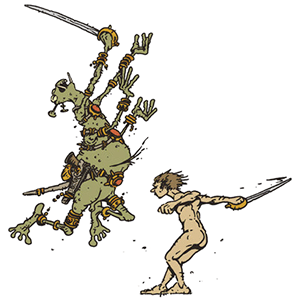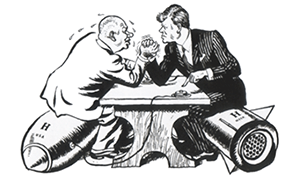Barsoom is a fictional representation of the planet Mars created by American pulp fiction author Edgar Rice Burroughs, who wrote close to 100 action adventure stories in various genres in the first half of the 20th century, and is now best known as the creator of the character Tarzan. The first Barsoom tale was serialized as ‘Under the Moons of Mars’ in 1912, and published as a novel as ‘A Princess of Mars’ in 1917. Ten sequels followed over the next three decades, further extending his vision of Barsoom and adding other characters.
The world of Barsoom is a romantic vision of a dying Mars, based on now-outdated scientific ideas made popular by Astronomer Percival Lowell in the early 20th century. While depicting many outlandish inventions, and advanced technology, it is a savage world, of honor, noble sacrifice and constant struggle, where martial prowess is paramount, and where many races fight over dwindling resources. It is filled with lost cities, heroic adventures and forgotten ancient secrets.
read more »
Barsoom
John Carter
John Carter is a fictional character, created by Edgar Rice Burroughs, who appears in the ‘Barsoom’ novels. Although he is actually a Virginian from Earth and only a visitor to Mars, he is sometimes known as ‘John Carter of Mars,’ in reference to the setting in which his major deeds are recorded, in the tradition of other real-world heroes such as Lawrence of Arabia and Scipio Africanus. His character is enduring, having appeared in various media since his 1912 debut in a magazine serial.
John Carter first appeared in ‘A Princess of Mars,’ the first Burroughs novel set on a fictionalized version of Mars known as ‘Barsoom.’ His character and courtesy exemplify the ideals of the antebellum South. A Virginian, he served as a captain in the American Civil War on the side of the Confederacy. While hiding from Apaches in a cave, he appears to die; leaving his inanimate body behind, he is mysteriously transported by a form of astral projection to the planet Mars, where he finds himself re-embodied in a form identical to his earthly one. Accustomed to the greater gravity of Earth, he is much stronger and more agile than the natives of Mars due to its gravity.
Chicken
The game of chicken, also known as the hawk-dove or snowdrift game, is an influential model of conflict for two players in game theory. The principle of the game is that while each player prefers not to yield to the other, the worst possible outcome occurs when both players do not yield.
The name ‘chicken’ has its origins in a game in which two drivers drive towards each other on a collision course: one must swerve, or both may die in the crash, but if one driver swerves and the other does not, the one who swerved will be called a ‘chicken,’ meaning a coward; this terminology is most prevalent in political science and economics.
read more »
Nazar
A nazar is an eye-shaped amulet believed to protect against the evil eye. In Central Asia, during the ages of Tengrism (a shamanistic religion of that region), people held similar superstitions like horseshoes, garlic, wolf’s tooth, dried thorn, lead, stones; but the crystal blue eye has always been the most popular one.
It is common in Turkey, Armenia, Iran, Greece, Cyprus and Azerbaijan. In Turkey, the nazar is often hung in homes, offices, cars, children’s clothing, or incorporated in jewelry. A typical nazar is made of handmade glass featuring concentric circles or teardrop shapes in dark blue, white, light blue and black, occasionally with a yellow/gold edge.
Taubman Sucks
Taubman Sucks is an award-winning short documentary about a precedent-setting intellectual property lawsuit. The documentary was written and directed by filmmaker Theo Lipfert. The six-minute film explores Taubman v. WebFeats, a lawsuit that involved the complex relationships between domain names, trademarks, and free speech.
As the first ‘sucks.com’ case to reach the level of the United States Court of Appeals, the decision in Taubman v. WebFeats established precedents concerning the non-commercial use of trademarks in domain names.
Article Spinning
Article spinning is a search engine optimization technique by which blog or website owners post a unique version of relevant content on their sites by rewriting and replacing elements to provide a slightly different perspective on the topic. Many article marketers believe that article spinning helps avoid the feared penalties in the Search Engine Results pages (SERP) for using duplicate content. If the original articles are plagiarized from other websites or if the original article was used without the copyright owner’s permission, such copyright infringements may result in the writer facing a legal challenge, while writers producing multiple versions of their own original writing need not worry about such things.
Website owners may pay writers to perform spinning manually, rewriting all or parts of articles. Writers also spin their own articles, manually or automatically, allowing them to sell the same articles with slight variations to a number of clients or to use the article for multiple purposes (e.g. content and marketing). There are also a number of software applications which will automatically replace words or phrases in articles.
Spamdexing
In computing, spamdexing (also known as search spam or Search Engine Poisoning) is the deliberate manipulation of search engine indexes. The earliest known reference to the term is by Eric Convey in 1996 in an article, ‘Porn sneaks way back on Web,’ for ‘The Boston Herald.’ It involves a number of methods, such as repeating unrelated phrases, to manipulate the relevance or prominence of resources indexed in a manner inconsistent with the purpose of the indexing system.
Common spamdexing techniques can be classified into two broad classes: content spam (or term spam) and link spam. Content spam methods include keyword stuffing, hidden or invisible text, meta-tag stuffing, doorway pages, scraper sites, and article spinning. Link spamming methods include link farms, hidden links, Sybil attacks, spam blogs, page hijacking, buying lapsed domains (cybersquatting), and cookie stuffing.
read more »
Brandjacking
Brandjacking is an activity whereby someone acquires or otherwise assumes the online identity of another entity for the purposes of acquiring that person’s or business’s brand equity. The term combines the notions of ‘branding’ and ‘hijacking’, and has been used since at least 2007 when it appeared in a Business Week article. The tactic is often associated with use of individual and corporate identities on social media or Web 2.0 sites.
While similar to cybersquatting, identity theft, and phishing, brandjacking is usually particular to a politician, celebrity or business and more indirect in its nature. A brandjacker may attempt to use the reputation of its target for selfish reasons or seek to damage the reputation of its target for malicious or for political reasons. These reasons may not be directly financial, but the effects on the original brand-holder may often include financial loss – for example, negative publicity may result in the termination of a celebrity’s sponsorship deal, or, for a corporation, potentially lead to lost sales or a reduced share price.
Cybersquatting
Cybersquatting (also known as domain squatting) is registering, trafficking in, or using a domain name with bad faith intent to profit from the goodwill of a trademark belonging to someone else. Some cybersquatter offer to sell the domain to the person or company who owns a trademark at an inflated price.
Some put up derogatory remarks about the person or company the domain is meant to represent to encourage the subject to buy the domain from them. Others post paid links via Google and other advertising networks. The term is derived from ‘squatting,’ which is the act of occupying an abandoned or unoccupied space or building that the squatter does not own, rent or otherwise have permission to use.
read more »












